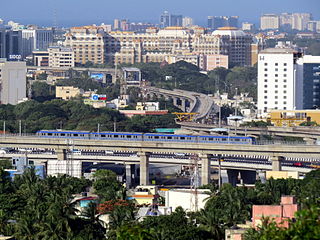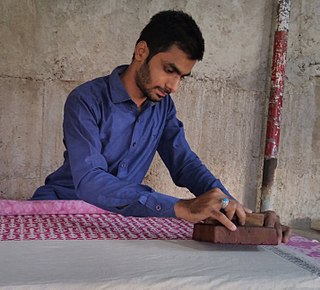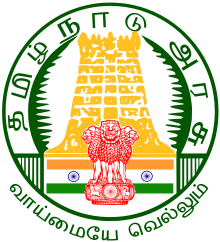
Gobichettipalayam is a town and municipality in Erode district of the Indian state of Tamil Nadu. It is the administrative headquarters of Gobichettipalayam taluk. It is situated at the center of the South Indian Peninsula at 213 metres (699 ft) above sea level, surrounded by Western Ghats. It is located 35 kilometres (22 mi) from the district headquarters Erode, 44 kilometres (27 mi) from Tiruppur and 80 kilometres (50 mi) from Coimbatore. Agriculture and textile industries contribute majorly to the economy of the town.

Mysore Silk is variety of mulberry silk produced in the Indian district of Mysore, Karnataka.

Salem District is one of the 38 districts of Tamil Nadu state in southern India. The district is now divided into Dharmapuri, Krishnagiri, Namakkal as individual districts. Salem is the district headquarters and other major towns in the district include Mettur, Thammampatti, Attur, Omalur, Sangagiri and Edappadi. That Salem dates to at least two thousand years ago is evident from the discovery of silver coins from the Roman Emperor Nero Claudius Caesar Augustus Germanicus found by Koneripatti of Salem in 1987. It was ruled by Mazhavar King Kolli Mazhavan and kings Adhiyaman and Valvil Ori of Sangam age. It is part of Mazhanadu, a vast region that dates to the second century BCE. Salem was the largest district of Tamil Nadu. It was bifurcated into Salem and Dharmapuri districts in 1965 and Namakkal district in 1997. Now Salem has been developed a lot by building many bridges and is considered to be the smart city. Salem is famous for cultivating mangoes.
Chennimalai is a town in Erode district, Tamil Nadu, India. It is popularly known as the 'Handloom Town'.

India Brand Equity Foundation (IBEF) is a Trust established by the Department of Commerce, Ministry of Commerce and Industry, Government of India. IBEF's primary objective is to promote and create international awareness of the Made in India label in markets overseas and to facilitate the dissemination of knowledge of Indian products and services. Towards this objective, IBEF works closely with stakeholders across government and industry.

Avinashi is a municipality in Tiruppur district in the Indian state of Tamil Nadu. Avinashi is one among the nine taluks of the district. It is one of the popular pilgrim destinations in Western Tamil Nadu region. It is located on National Highway NH544, which bypasses the town. The history of the town is centered around the Avinasilingeswarar temple. The town was previously a part of the Coimbatore district until Tirupur was carved out as a separate district from the erstwhile districts of Coimbatore and Erode. It is a stopping place for vehicles travelling from the western part of Tamil Nadu to Chennai and Cochin.

Tamil Nadu has the second largest state economy in India. The state also hosts the highest number of factories in the country. The state is 48.40% urbanised, accounting for around 9.26% of the urban population in the country, while the state as a whole accounted for 5.96% of India's total population in the 2011 census. Services contributes to 54% to the gross domestic product of the state, followed by manufacturing at 33% and agriculture at 13%.

The Ministry of Textiles is an Indian government national agency responsible for the formulation of policy, planning, development, export promotion and regulation of the textile industry in India. This includes all natural, artificial, and cellulosic fibers that go into the making of textiles, clothing and Handicrafts.

The Tamil Nadu Handloom Weavers' Cooperative Society, popularly known as Co-optex, is a cooperative of traditional handloom weavers of the Indian state of Tamil Nadu. This is under the control of Department of Handlooms, Handicrafts, Textiles and Khadi of Government of Tamil Nadu. The organisation owns a number of shopping outlets in Tamil Nadu. Co-Optex also has an international arm, Co-optex International which exports its products to Germany, France, Netherlands, Belgium, Spain, Switzerland, Canada, Greece, Hong Kong, U.K. South Africa and the U.A.E.
The textile industry in India traditionally, after agriculture, is the only industry that has generated huge employment for both skilled and unskilled labour. The textile industry continues to be the second-largest employment generating sector in India. It offers direct employment to over 35 million people in the country. India is the world's second largest exporter of textiles and clothing, and in the fiscal year 2022, the exports stood at US$ 44.4 billion. According to the Ministry of Textiles, the share of textiles in total exports during April–July 2010 was 11.04%. During 2009–2010, the Indian textile industry was pegged at US$55 billion, 64% of which services domestic demand. In 2010, there were 2,500 textile weaving factories and 4,135 textile finishing factories in all of India. According to AT Kearney’s ‘Retail Apparel Index’, India was ranked as the fourth most promising market for apparel retailers in 2009.

The crafts of India are diverse, rich in history, culture and religion. The craft of each state in India reflect the influence of different empires. Throughout centuries, crafts have been embedded as a culture and tradition within rural communities.
The handloom industry is one of the most ancient cottage industries in Salem district of Tamil Nadu, India. Salem was one of the primary handloom centers of south India. Sari, dhoti and angavasthram are made out of silk yarn and cotton yarn. In the recent past, home furnishing items are also woven, mainly for export purposes. More than 75,000 handlooms are working and the total value of cloth produced per annum is estimated at Rs.5,000 crores
Government of Tamil Nadu governs the Indian state of Tamil Nadu. The Governor of Tamil Nadu is the constitutional head of state while the Chief Minister heads the executive branch acting along with the council of ministers. The ministers are responsible for the administration of various departments of the government.

The Department of Labour Welfare and Skill Development is one of the departments of Government of Tamil Nadu.
Handicrafts and Handlooms Export Corporation of India was an agency of Ministry of Textiles, Government of India established in 1958 with main objectives to undertake exports of handicrafts, handlooms products, khadi and products of village industries from India and to undertake special promotional measures.
Kovai Cora cotton or Kovai Kora cotton is a type of saree made in the Coimbatore region in Tamil Nadu, India. It has been recognized as a Geographical indication by the Government of India in 2014–15. The Devanga community are pioneers in weaving Kovai Kora cotton saris. 82 Weaver cooperative Societies in Coimbatore, Tiruppur and Erode are authorised to sell Kovai Kora cotton saris.
Dhirendra Kumar is an Indian Forest Service Officer of 1983 batch. Born on 22 December 1954, he was a former Special Secretary, Industry Department cum Director of Sericulture, Handloom and Handicraft, Government of Jharkhand and Managing Director of Jharkhand Silk Textile and Handicraft Development Corporation (Jharcraft) Before Joining to the forest services, he did his Post Graduation in Geology from Ranchi University and then served as lecturer at St. Xavier’s College, Ranchi.

Handloom saris are a traditional textile art of Bangladesh and India. The production of handloom saris is important for economic development in rural India.

Tiruppur or Tirupur ( ), is a city in the Indian state of Tamil Nadu. It is located on the banks of the Noyyal river and is the fourth largest urban agglomeration in Tamil Nadu. It is the administrative capital of Tiruppur district and is administered by the Tiruppur Municipal Corporation which was established in 2008.
Ahimsapuram is a neighbourhood in Madurai district of Tamil Nadu state in the peninsular India. Ahimsapuram has a numerous handloom weaving units that produce towels and export them to several countries. Important streets of Ahimsapuram include:
- Ahimsapuram 1st street
- Ahimsapuram 2nd street
- Ahimsapuram 3rd street
- Ahimsapuram 4th street
- Ahimsapuram 5th street
- Ahimsapuram 6th street
- Ahimsapuram 7th street
- Ahimsapuram 8th street.












